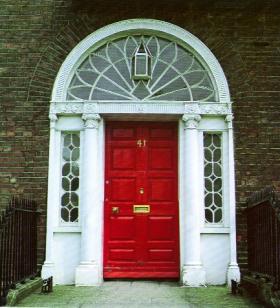‘Bare bones of a fanlight’: Georgian Dublin
Published in 18th-19th Century Social Perspectives, 18th–19th - Century History, Issue 5 (Sep/Oct 2006), News, Volume 14
Education must play a role in encouraging a greater awareness of the legacy of Georgian Dublin to ensure that we maintain what has survived from the period. (Bord Fáilte)
The cultural legacy of this period was discussed by W. J. McCormack in his paper on the Edward Worth library and by Johanna Archibold in her talk on the most extensive print enterprise of the eighteenth century in Ireland, James Moore’s publication of the Encyclopaedia Britannica. Other papers drew attention to the wide-ranging concerns of the conference, including John Montague’s analysis of shopping arcades in Georgian Dublin, which focused on the Essex Street piazzas and recreated aspects of John Rocque’s 1756 map of Dublin. The broadening historical concerns of the architecture of the city were drawn out in Dáire Keogh’s paper ‘Winter’s end: Catholicism, religion and practice 1770–1820’, which discussed a 50-year period that saw a surge in Catholic church-building. Gillian O’Brien discussed the impressions of visitors to the city in the aftermath of the Act of Union, and her paper drew on the political as well as the architectural and economic impressions that these travellers presented of Ireland. Kariann Yokota (Yale) placed Georgian Dublin in an international context through her discussion of the influence of Dublin merchants on their American customers.
Throughout the conference participants reflected on the loss of many parts of Georgian Dublin and in particular on the role of the minister for local government, Kevin Boland, who in 1970 expressed his disdain for the preservation of these eighteenth-century buildings and described the advocates of conservation as ‘belted earls and their ladies’. They were
‘. . . left-wing intellectuals who can afford the time to stand and contemplate in ecstasy the unparalleled man-made beauty of the two corners of Hume Street and St Stephen’s Green [who] may well feel that the amateurish efforts of Mother Nature in the Wicklow Mountains are unworthy of their attention’.
The final day of the conference drew out this particular theme, with Ian Lumley, heritage officer of An Taisce, presenting a lecture on the battle for the preservation of Georgian Dublin. The lecture focused not just on the successes and failures of these campaigns but also on the effects of urban sprawl and the future threat to Georgian Dublin, global warming and rising sea levels. He was followed by Emmeline Henderson from the Irish Georgian Society, who discussed the foundation of the society and the Georgian ideal.
The conference concluded with a forum on the future of Georgian Dublin, and participants included Frank McDonald from the Irish Times, Professor Kevin B. Nowlan of the Irish Georgian Society and Ian Lumley. Reflecting on the uniqueness of the city, the animated discussion drew out the need for further protective legislation to ensure future preservation. Professor Nowlan stressed the role that education must play in encouraging a greater awareness of the legacy of Georgian Dublin to ensure that we maintain what has survived from the period.
















